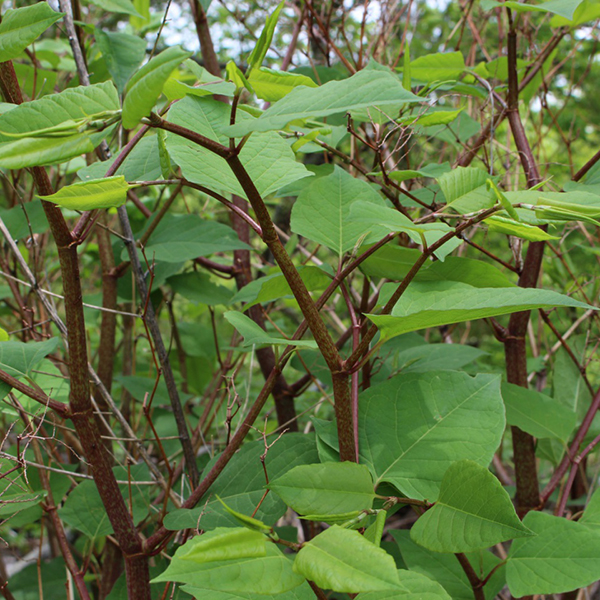By R. Wayne Mezitt
Japanese bamboo, Mexican bamboo and Japanese fleece flower are other common names for Polygonum cuspidatum (it is called Fallopia japonica in Britain), widely considered one of the most invasive plants in this region (and many other locations worldwide). Whatever you call it, once this ubiquitous plant shows up in your landscape, you should make every effort to eliminate it before it becomes unmanageable.
Introduced to England as an ornamental plant around 1825, Japanese knotweed started being used in USA for hedging, screening and erosion control later in the 1800’s. Although the appearance of its stems resembles bamboo, it is actually an herbaceous member of the buckwheat family. Its above-ground parts die during the winter, and all new growth springs from its underground rhizomes. Now naturalized nationwide, it forms dense thickets along roadways, stream-banks and abandoned waste areas, and increasingly in landscape plantings.
Japanese knotweed is easy to spot any time of year: its round, green-speckled, red-brown, inch-thick, hollow stems are thick and woody, standing tall even during the winter. Six-inch sprays of tiny, greenish-white flowers sprout from leaf axils in mid-summer, followed in autumn by a profusion of dangling, triangular, winged nut-like seeds as the foliage turns yellow. Thriving in any sunny location and reaching 6-10 ft. high, its vigorous underground rhizomes sprout thick stems at every node, quickly spreading to 20-30 ft. wide and more. It dominates landscapes and crowds out anything in its path and also invades new areas with its prolific seed production.
In your yard, small plants should be carefully and thoroughly dug out, taking care to leave not even the smallest piece of root–it will grow into a new plant. Be sure to dispose of all parts of knotweed where they cannot regrow, not in your compost pile! Cut-back all new shoots continuously as they emerge; this helps starve the root systems. Alternatively, a foliar application of glyphosate herbicide (Roundup, or similar) will set-back new growth, but treatment must be repeated every time new shoots appear. Another method is to apply glyphosate concentrate directly to each stem as it is cut, enabling the herbicide to translocate to the root systems and weaken them.
Eradicating larger established infestations of Japanese knotweed is a more complex process, and it can take a year or more; Japanese knotweed’s rhizomes survive for a long time underground, even when new shoots are continuously cut off or treated with herbicide. A diligent control program that combines mechanical and chemical management can work, although you may need to call upon a professional for more extreme infestations. In any case, once you see this invasive pest moving into the landscape, be sure to take appropriate action to help impede its further spread.







